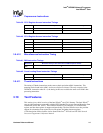
112 Hardware Reference Manual
Intel
®
IXP2800 Network Processor
Intel XScale
®
Core
3.9.1 Interrupt Latency
Minimum Interrupt Latency is defined as the minimum number of cycles from the assertion of any
interrupt signal (IRQ or FIQ) to the execution of the instruction at the vector for that interrupt. The
point at which the assertion begins is TBD. This number assumes best case conditions exist when
the interrupt is asserted, e.g., the system isn’t waiting on the completion of some other operation.
A useful number to work with is the Maximum Interrupt Latency. This is typically a complex
calculation that depends on what else is going on in the system at the time the interrupt is asserted.
Some examples that can adversely affect interrupt latency are:
• The instruction currently executing could be a 16-register LDM.
• The processor could fault just when the interrupt arrives.
• The processor could be waiting for data from a load, doing a page table walk, etc.
• There are high core-to-system (bus) clock ratios.
Maximum Interrupt Latency can be reduced by:
• Ensuring that the interrupt vector and interrupt service routine are resident in the instruction
cache. This can be accomplished by locking them down into the cache.
• Removing or reducing the occurrences of hardware page table walks. This also can be
accomplished by locking down the application’s page table entries into the TLBs, along with
the page table entry for the interrupt service routine.
3.9.2 Branch Prediction
The Intel XScale
®
core implements dynamic branch prediction for the ARM* instructions B and
BL and for the Thumb instruction B. Any instruction that specifies the PC as the destination is
predicted as not taken. For example, an LDR or a MOV that loads or moves directly to the PC will
be predicted not taken and incur a branch latency penalty.
These instructions -- ARM B, ARM BL and Thumb B -- enter into the branch target buffer when
they are “taken” for the first time. (A “taken” branch refers to when they are evaluated to be true.)
Once in the branch target buffer, the Intel XScale
®
core dynamically predicts the outcome of these
instructions based on previous outcomes. Table 26 shows the branch latency penalty when these
instructions are correctly predicted and when they are not. A penalty of 0 for correct prediction
means that the Intel XScale
®
core can execute the next instruction in the program flow in the cycle
following the branch.
Table 26. Branch Latency Penalty
Core Clock Cycles
Description
ARM* Thumb
+0 + 0
Predicted Correctly. The instruction is in the branch target cache and is
correctly predicted.
+4 + 5
Mispredicted. There are three occurrences of branch misprediction, all of which
incur a 4-cycle branch delay penalty.
1. The instruction is in the branch target buffer and is predicted not-taken, but is
actually taken.
2. The instruction is not in the branch target buffer and is a taken branch.
3. The instruction is in the branch target buffer and is predicted taken, but is
actually not-taken


















